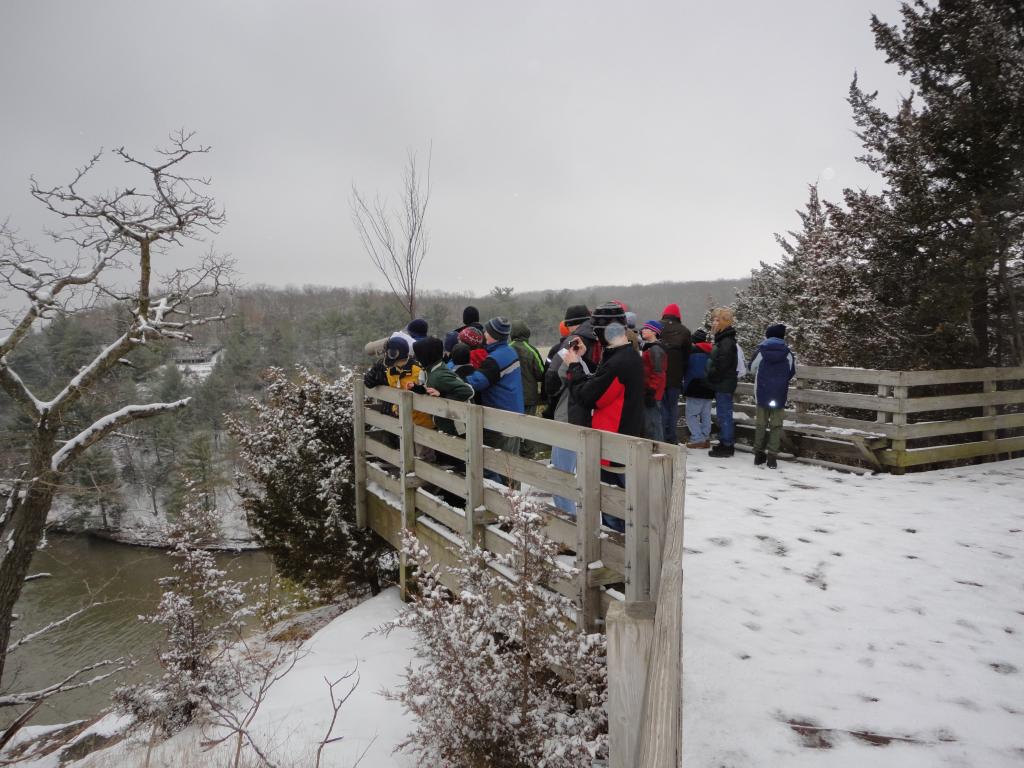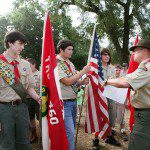![By David Fine (This image is from the FEMA Photo Library.) [Public domain], via Wikimedia Commons](https://wp-media.patheos.com/blogs/sites/533/2015/11/FEMA_-_44431_-_Boy_scouts_Place_Flags_at_Tennesse_National_Memorial_Cemetery-1024x682.jpg)
Some time ago, I read a book titled “Is Marriage for White People?” which used that clever title to entice readers into a book on the decline of marriage among blacks. As I recall, it was not trapped in the accusations of “black women are welfare queens who want Uncle Sam to provide for them” but had a lot of food for thought. I thought I had blogged about it, but it seems this was a pre-blogging book.
I’m reminded of that because of another “for white people” item: Scouting, and Cub/Boy Scouting in particular.
Here’s what has me thinking about it: I am the committee chair for the Cub Scout pack chartered by our parochial school. To the east and the west of us are two packs nominally chartered by churches but in practice operating for the benefit of boys from the public schools. It’s all very middle class; the apartment-dwelling families exist but are pretty few in number.
To the south is another school, in an upper-middle-class neighborhood just like ours. Their school has no affiliated Cub Scout pack, and the question arose of whether we, as a smaller pack, should invite these families to join up with us. I did some looking into this over the weekend, and found out from the leaders of the west-of-us and the east-of-us packs that they had invited boys from this school, but got little to no response, and the pack that had been at that school, had folded some years ago due to lack of volunteers.
So I looked around on the internet, and I looked at the school itself. Although it’s located in a middle-class neighborhood, it has little in common with the east/west schools. It’s in a wholly different school district, due to the fact that, around here, school districts have little to do with city boundaries. Our school district has 3% of children in poverty. The south school’s school district has 59% of children living in poverty, and at this particular school, the rate is 66%. What’s more, the school is 59% Hispanic, and has a large number of recent immigrants. (No links intentionally.) Looking at the school attendance boundaries, the immediate neighborhood is only a small part of the school’s population and the school is at the very edge of its attendance area; the remainder is primarily a long stretch of apartment complexes along a stretch of road populated with Hispanic and Polish shops. If I look at the overall boundary map, the schools’ boundaries are very quirky; perhaps they were drawn to “fairly” allocate poor and immigrant families among the various schools in the district.
So it immediately makes sense to me that an invitation to an immigrant family to join a Cub Scout pack in what amounts to the next town over would be a hard sell. Why more parents from that “good” neighborhood didn’t take up the invitation I don’t know, unless it’s a matter of those parents being disengaged from the school and its activities because they feel like, in the school environment, they would have to carry the entire volunteer burden.
But that context led me to look at the overall issue of scout recruiting. How does one provide scouting opportunities to these boys? — and I’m speaking not just of this particular school, but of immigrant kids in general. After all, part of the reasoning behind the new “girl Cub Scouts” is the outreach to Hispanic and Asian families, based on an understanding that, at least according to their analysis, they wanted activities that the whole family could do together. In the presentation we viewed at our “roundtable” the specific example was given of Cub Scout meetings that took place with the whole group, and with different dens splitting up for den-specific activities within that larger meeting. (At least, that’s how I understood it.)
But even with this model, there have to be adult leaders. Cub Scouts isn’t just a “thing” that happens on it’s own, nor is it like civic leaders nagging a grocery store chain to open up a location in a poor area. Scouting needs volunteers. In fact, while a Girl Scout troop can set up shop with a single White-Savior woman coming in as a good deed, say, to an immigrant community center, as described in this 2016 Atlantic article (which features just a lone troop leader leading the girls in crafts projects and citing hopes for summer camping), a Cub Scout pack needs an assortment of leaders: Cubmaster, Committee Chair, Treasurer, den leaders, and enough assorted adults to meet two-deep leadership requirements at all activities.
Summer camping, too, in Girl Scouts is managed at the council level: sign your daughter up for a session and you’re set — which makes it possible for some charitable organization or another to “send a girl to camp” with donations. At the Boy Scouts, boys go camping with their troops, which, again, requires leaders/parent volunteers to make it happen.
So take a look at these maps:
The first is our general suburban area.
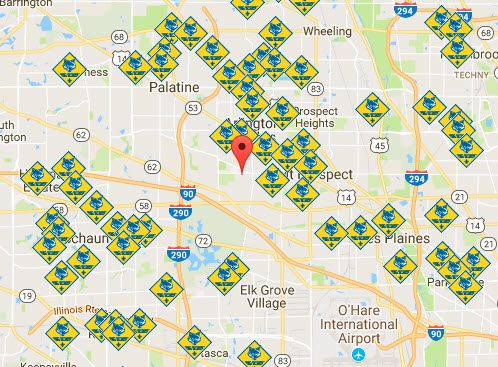
The second is the west side of Chicago:
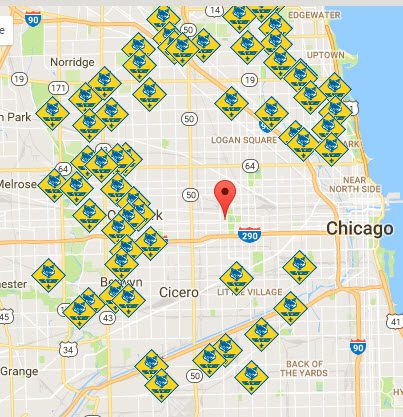
And the third, the south side of Chicago:
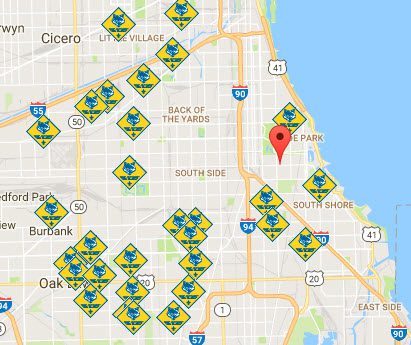
Because, yes, if you know me, you know that I can spend way too much time studying maps. In the first case, the “void” is due to an area with lost of nature areas, commercial areas, and very low density zoning. In the second and third maps, there is, so far as I can tell, no such convenient explanation, except that these are poor/immigrant areas.
But what do you do about this?
The BSA national organization is trying. After all, they think that they have an organization that meshes with the values that Hispanic families want for their children. In an undated publication, they say,
The Boy Scouts of America is fortunate to have a mission statement, Scout Oath, and Scout Law consistent with the values and principles cherished by most Hispanic Americans. The concept of “helping others at all times” reinforces the Hispanic cultural belief of caring and showing respect toward others, especially those who are less fortunate. “Duty to God and country” is another Scouting ideal consistent with the qualities that Hispanic Americans expect of their young people: God-fearing, patriotic, drug-free and gang-free, responsible young citizens.
And in a report titled “Reaching the Next Multicultural Generation,” also undated, they describe the results of focus groups with immigrant and minority parents, ideas on how to recruit, program characteristics to emphasize with each of Hispanic, Asian, and black parents. And some of their answers are discouraging: for instance, some examples of ways black families can be reached are by discarding the uniform in favor of “cool” t-shirts, and using celebrities (e.g, rappers) to market to them. Hispanic and Asian parents want activities that preserve their cultural heritage. I get the impression that this path is towards one in which Scouting, rather than being a tool for assimilation in which immigrant boys join with their native-born peers, becomes a tool for continued social segregation, akin to those churches which stood side-by-side but ministered to different immigrant populations, with the community-specific cultural centers serving as recruitment sites for families and volunteers alike. And maybe neighborhoods are already so segregated that there is no integrationalist alternative.
Finally, Wikipedia describes a BSA initiative, ScoutReach, focused on reaching minority youth — but I can’t find any recent materials on the BSA website, so it’s not clear to me what the current status of the program is.
As usual, readers, your thoughts?
Image: By David Fine (This image is from the FEMA Photo Library.) [Public domain], via Wikimedia Commons




